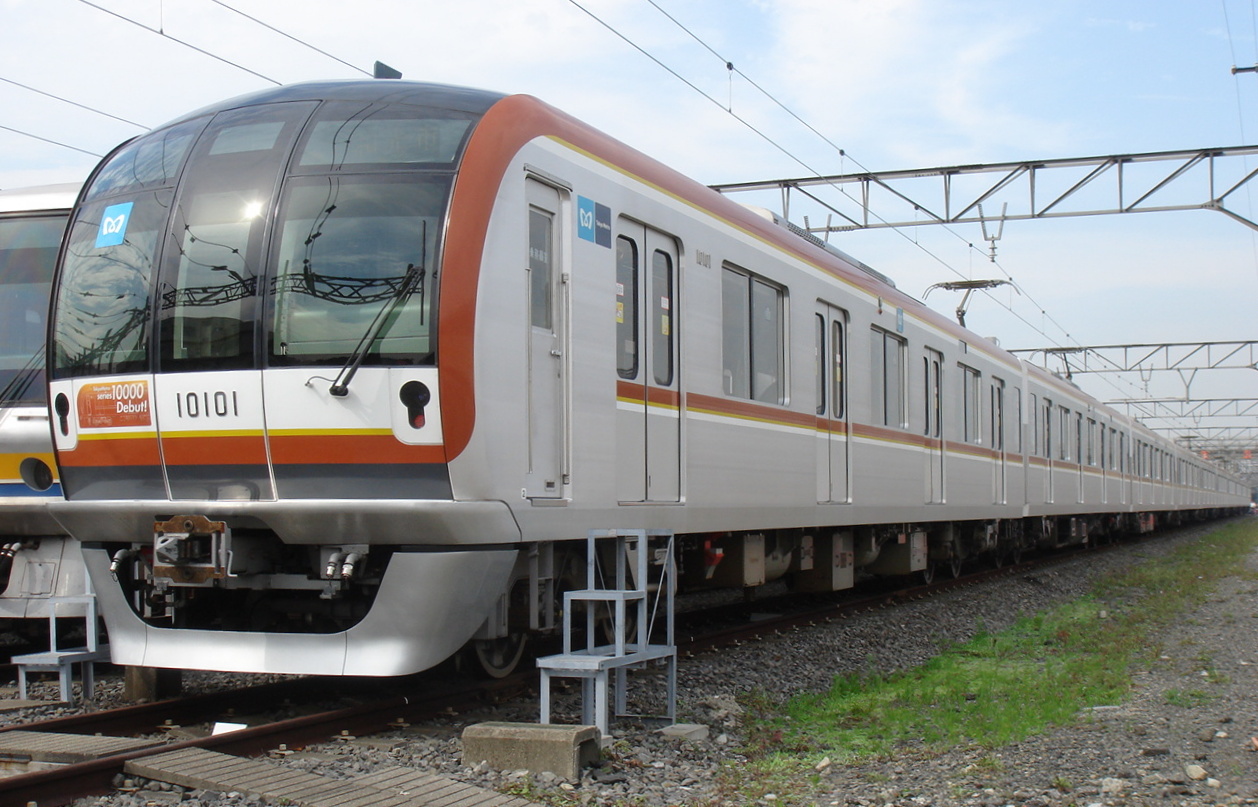- Tōkyō Metro 10000 series
Infobox EMU
name = Tōkyō Metro 10000 series
imagesize = 240px
background=#BA6832
caption = 10000 series set 10101 at Shinkiba depot, December 2006
InService = 2006 - Present
Manufacturer = Hitachi
Family =A-train
Built = Under Delivery
Refurbishment =
Formation = 8/10 cars per trainset
Operator =Tokyo Metro
Depots =
LinesServed =Tokyo Metro Fukutoshin Line ,Tokyo Metro Yūrakuchō Line ,Tōbu Tōjō Line ,Seibu Yūrakuchō Line
CarBody = Aluminium
CarLength = 20 m
CarWidth =
CarHeight =
MaxSpeed = 100 km/h (service) 120 km/h (design)
Weight =
Capacity =
Acceleration = 3.3 km/h/s
Deceleration = 3.5 km/h/s (4.5 km/h/s for emergency brake)
Traction =
Power =
Gauge = 1,067 mm
Voltage = 1,500 V DC overhead
Brakes = The Nihongo|10000 series|東京地下鉄10000系電車|Tōkyō Metoro 10000 kei densha is anelectric multiple unit which operates on the Yūrakuchō and Fukutoshin subway lines ofTokyo Metro (formerly known as "Eidan").Design
The trains are manufactured by Hitachi with aluminium bodies to its "A-train" concept.
The 10000 series is the first new model to be built for Tokyo Metro following privatization. The front-end design is intended to evoke the appearance of the 300 series trains, which were the first trains used on the Marunouchi Line. [ [http://journal.mycom.co.jp/news/2006/10/02/320.html "東京メトロ、民営化後初の新型車両「10000系」を車両基地で一般公開",
2 October 2006 ] ] The train whistles also use the same type as the old train used on the Ginza Line.On set numbers 10105 onward, built from 2007, the gold colour line was omitted on the front ends.
Lines
The fleet of 10-car sets currently operate on the Yūrakuchō and Fukutoshin lines, including inter-running services over the
Tōbu Tōjō Line betweenWakōshi Station and Shinrinkōen Station, and also services over the Seibu Yūrakuchō and Ikebukuro Lines betweenKotake-mukaihara Station andHannō Station .The trains are designed to allow two intermediate cars (cars 4 and 5) to be removed easily to create 8-car sets when through-running commences from the Fukutoshin Line to the
Tōkyū Tōyoko Line in 2012. Five sets (10101 to 10105) were reformed as 8-car sets from the start of Fukutoshin Line services in June 2008 to cover for a shortage in 8-car 7000 series trainsets. These sets are identified by the addition of "8 CARS" stickers on the cab windows. ["Japan Railfan Magazine", September 2008 issue, p.62-63]History
The first set was delivered in May 2006, and entered service on the Yūrakuchō Line and Tōbu Line in September 2006. 10000 series sets entered service on the Seibu Line in February 2007.
At the start of Fukutoshin Line services in June 2008, a total of 22 sets had been delivered. ["Tetsudō Daiya Jōhō" magazine, July 2008 issue, p.39]
Technical details
*Traction motor output: 165 kW (IGBT-VVVF control)
*Gear ratio: 6.21 (87:14)
*Headlights: HID
*Destination indicators: 3-colour LED
*Passenger information displays: LCD screens (8 per car)
*Seating arrangement (intermediate cars): 3-7-7-7-3
*Driver's cab: Single handle ("T" type)References
Wikimedia Foundation. 2010.
